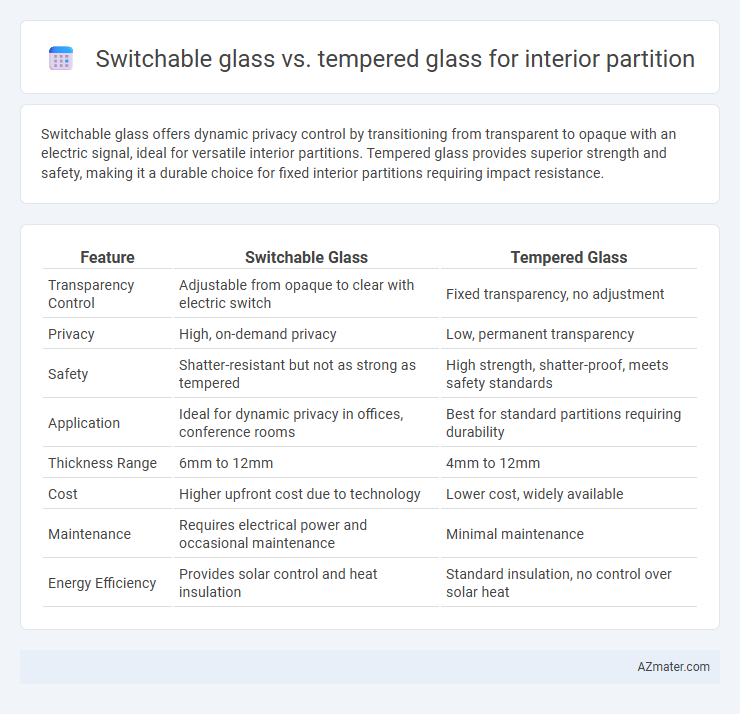Switchable glass offers dynamic privacy control by transitioning from transparent to opaque with an electric signal, ideal for versatile interior partitions. Tempered glass provides superior strength and safety, making it a durable choice for fixed interior partitions requiring impact resistance.
Table of Comparison
| Feature | Switchable Glass | Tempered Glass |
|---|---|---|
| Transparency Control | Adjustable from opaque to clear with electric switch | Fixed transparency, no adjustment |
| Privacy | High, on-demand privacy | Low, permanent transparency |
| Safety | Shatter-resistant but not as strong as tempered | High strength, shatter-proof, meets safety standards |
| Application | Ideal for dynamic privacy in offices, conference rooms | Best for standard partitions requiring durability |
| Thickness Range | 6mm to 12mm | 4mm to 12mm |
| Cost | Higher upfront cost due to technology | Lower cost, widely available |
| Maintenance | Requires electrical power and occasional maintenance | Minimal maintenance |
| Energy Efficiency | Provides solar control and heat insulation | Standard insulation, no control over solar heat |
Introduction to Switchable Glass and Tempered Glass
Switchable glass, also known as smart glass, changes from transparent to opaque using an electric current, providing privacy and light control in interior partitions. Tempered glass is heat-treated for increased strength and safety, making it resistant to impact and thermal stress. Both materials offer unique benefits for interior partition applications, with switchable glass enhancing flexibility and tempered glass ensuring durability.
How Switchable Glass Works
Switchable glass uses an electrochromic film embedded between glass panes that changes from opaque to transparent when an electrical current is applied, allowing dynamic control of privacy and light transmission in interior partitions. Tempered glass, on the other hand, is heat-treated for enhanced strength and safety but remains static in appearance and cannot switch states. The ability of switchable glass to instantly transform its opacity makes it an innovative solution for adaptable office and residential spaces requiring privacy on demand.
Understanding Tempered Glass: Features and Benefits
Tempered glass for interior partitions offers enhanced strength and safety due to its heat-treated process, making it resistant to impacts and thermal stress. Its ability to shatter into small, blunt pieces reduces injury risks, which is ideal for high-traffic office spaces or commercial environments. The durability and clarity of tempered glass ensure long-lasting performance while maintaining aesthetic appeal in modern interior designs.
Key Differences in Functionality
Switchable glass offers dynamic transparency control by using an electric current to toggle between opaque and clear states, enhancing privacy and light management in interior partitions. Tempered glass, on the other hand, provides superior strength and safety through heat treatment but maintains a fixed transparency without flexibility in light control. While switchable glass excels in adaptability and modern smart design, tempered glass is preferred for durability and impact resistance in high-traffic areas.
Privacy Control: Switchable vs Tempered Glass
Switchable glass offers dynamic privacy control by instantly changing from transparent to opaque with the flip of a switch, making it ideal for flexible interior partitions. Tempered glass, while strong and durable, provides only fixed transparency and requires additional treatments like frosting or blinds to achieve privacy. For spaces requiring adaptable privacy, switchable glass outperforms tempered glass by enabling on-demand opacity without compromising design aesthetics.
Design Flexibility for Interior Spaces
Switchable glass offers superior design flexibility for interior partitions by allowing instant control over transparency, enhancing privacy without sacrificing natural light or open space aesthetics. Tempered glass provides durability and safety but lacks the dynamic visual adaptability of switchable glass, limiting stylistic options to fixed transparency. Integrating switchable glass in interior spaces supports innovative design concepts that balance functionality and modern elegance.
Durability and Safety Comparisons
Switchable glass offers advanced safety features with its ability to transition from transparent to opaque, providing privacy without sacrificing structural integrity, but it is generally less impact-resistant compared to tempered glass, which boasts superior durability and shatter-resistant properties due to its heat-treated construction. Tempered glass is designed to break into small, blunt pieces, reducing injury risk, while switchable glass typically incorporates a laminated layer to enhance safety but may not match the toughness of tempered glass under heavy impact. For interior partitions, tempered glass remains the preferred choice for maximum durability and impact safety, whereas switchable glass prioritizes flexibility and privacy with moderate safety standards.
Energy Efficiency and Light Management
Switchable glass offers superior energy efficiency by controlling heat transfer and reducing reliance on artificial lighting through its ability to switch between transparent and opaque states, enhancing natural light management. Tempered glass provides strength and safety but lacks dynamic light control, resulting in higher energy consumption for heating, cooling, and lighting. Incorporating switchable glass in interior partitions optimizes energy use while maintaining privacy and maximizing daylight.
Cost Considerations and Maintenance Needs
Switchable glass for interior partitions typically incurs higher upfront costs due to advanced technology and electrical components, whereas tempered glass offers a more budget-friendly option with a simpler manufacturing process. Maintenance of switchable glass involves regular electrical inspections and potential repairs to the film's switching mechanism, increasing long-term expenses compared to tempered glass, which requires minimal upkeep mainly focused on cleaning and occasional surface inspections. Cost-effective solutions often favor tempered glass when prioritizing durability and low maintenance, while switchable glass is preferred for its dynamic privacy features despite higher initial and ongoing costs.
Choosing the Right Glass for Your Interior Partition
Switchable glass offers privacy on demand by changing from transparent to opaque with electric control, making it ideal for adaptable interior partitions in offices and meeting rooms. Tempered glass provides superior strength and safety, resisting impact and thermal stress, making it suitable for high-traffic areas requiring durability. Choosing between switchable and tempered glass depends on whether dynamic privacy or structural robustness is the primary requirement for the interior partition.

Infographic: Switchable glass vs Tempered glass for Interior partition
 azmater.com
azmater.com